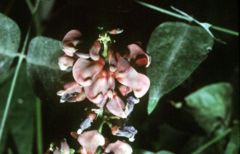Apios americana: Difference between revisions
No edit summary |
No edit summary |
||
| Line 1: | Line 1: | ||
{{SPlantbox | {{SPlantbox | ||
|genus=Apios | |familia=Fabaceae | ||
|genus=Apios | |||
|species=americana | |species=americana | ||
|Temp Metric=°F | |Temp Metric=°F | ||
|jumpin=If this plant info box on watering; zones; height; etc. is mostly empty you can click on the edit tab and fill in the blanks! | |jumpin=If this plant info box on watering; zones; height; etc. is mostly empty you can click on the edit tab and fill in the blanks! | ||
|image= | |image=Apios_americana.jpg | ||
|image_width=240 | |image_width=240 | ||
}} | }} | ||
'''''Apios americana''''', sometimes called the '''hog peanut''', '''potato bean''', or '''groundnut''' (but not to be confused with other plants sometimes known by the name [[groundnut]]) is a [[perennial plant|perennial]] [[vine]] native to eastern [[North America]], and bears edible [[bean]]s and large edible [[tuber]]s. It grows to 3-4 m long, with pinnate [[leaf|leaves]] 8-15 cm long with 5-7 leaflets. The [[flower]]s are red-brown to purple, produced in dense [[raceme]]s. The [[fruit]] is a [[legume]] (pod) 6-12 cm long. | |||
The tubers are crunchy and nutritious, with a high content of [[starch]] and especially [[protein]]. The plant was one of the most important food plants of pre-[[Europe]]an North America, and is now being developed for [[domestication]]. | |||
{{Inc| | {{Inc| | ||
Apios tuberosa, Moench. Groundnut. Wild Bean | Apios tuberosa, Moench. Groundnut. Wild Bean. Four to 8 ft., climbing over bushes: root bearing strings of edible tubers, 1-2 in. long: lfts. 5-7, ovate-lanceolate: fls fragrant, chocolate-brown, the standard very broad and turned back, the keel long, incurved and scythe-shaped. July, Aug.—Common in low grounds and swamps. The fr. often fails to mature. Prop, by the tubers. 2-4 of which should be planted together at a depth of 3-4 in.; also, by seeds. Grows well in the wild border, in any loose, rich soil. Under these conditions, the plant covers a trellis or other support in a comparatively short time. Dry tubers offered by seedsmen are likely to start slowly. The brown of the fls. is a very unusual color in hardy herbs. Likely to become a weed in rockeries and wild gardens. | ||
}} | }} | ||
==Cultivation== | |||
===Propagation=== | |||
===Pests and diseases=== | |||
==Varieties== | |||
==Gallery== | |||
<gallery perrow=5> | |||
Image:Upload.png| photo 1 | |||
Image:Upload.png| photo 2 | |||
Image:Upload.png| photo 3 | |||
</gallery> | |||
== | ==References== | ||
* [ | <references/> | ||
* | *[[Standard Cyclopedia of Horticulture]], by L. H. Bailey, MacMillan Co., 1963 | ||
* | <!--- xxxxx *Flora: The Gardener's Bible, by Sean Hogan. Global Book Publishing, 2003. ISBN 0881925381 --> | ||
<!--- xxxxx *American Horticultural Society: A-Z Encyclopedia of Garden Plants, by Christopher Brickell, Judith D. Zuk. 1996. ISBN 0789419432 --> | |||
<!--- xxxxx *Sunset National Garden Book. Sunset Books, Inc., 1997. ISBN 0376038608 --> | |||
{{ | ==External links== | ||
*{{wplink}} | |||
{{stub}} | |||
__NOTOC__ | |||
Latest revision as of 18:37, 19 January 2010
| Apios americana subsp. var. | ||||||||||||||||||||||||||||||||||||||||||||||||||||||||
|---|---|---|---|---|---|---|---|---|---|---|---|---|---|---|---|---|---|---|---|---|---|---|---|---|---|---|---|---|---|---|---|---|---|---|---|---|---|---|---|---|---|---|---|---|---|---|---|---|---|---|---|---|---|---|---|---|

|
|
| ||||||||||||||||||||||||||||||||||||||||||||||||||||||
| ||||||||||||||||||||||||||||||||||||||||||||||||||||||||
Apios americana, sometimes called the hog peanut, potato bean, or groundnut (but not to be confused with other plants sometimes known by the name groundnut) is a perennial vine native to eastern North America, and bears edible beans and large edible tubers. It grows to 3-4 m long, with pinnate leaves 8-15 cm long with 5-7 leaflets. The flowers are red-brown to purple, produced in dense racemes. The fruit is a legume (pod) 6-12 cm long.
The tubers are crunchy and nutritious, with a high content of starch and especially protein. The plant was one of the most important food plants of pre-European North America, and is now being developed for domestication.
| Standard Cyclopedia of Horticulture |
|---|
|
Apios tuberosa, Moench. Groundnut. Wild Bean. Four to 8 ft., climbing over bushes: root bearing strings of edible tubers, 1-2 in. long: lfts. 5-7, ovate-lanceolate: fls fragrant, chocolate-brown, the standard very broad and turned back, the keel long, incurved and scythe-shaped. July, Aug.—Common in low grounds and swamps. The fr. often fails to mature. Prop, by the tubers. 2-4 of which should be planted together at a depth of 3-4 in.; also, by seeds. Grows well in the wild border, in any loose, rich soil. Under these conditions, the plant covers a trellis or other support in a comparatively short time. Dry tubers offered by seedsmen are likely to start slowly. The brown of the fls. is a very unusual color in hardy herbs. Likely to become a weed in rockeries and wild gardens.
|
Cultivation
Propagation
Pests and diseases
Varieties
Gallery
-
photo 1
-
photo 2
-
photo 3
References
- Standard Cyclopedia of Horticulture, by L. H. Bailey, MacMillan Co., 1963
External links
- w:Apios americana. Some of the material on this page may be from Wikipedia, under the Creative Commons license.
- Apios americana QR Code (Size 50, 100, 200, 500)
